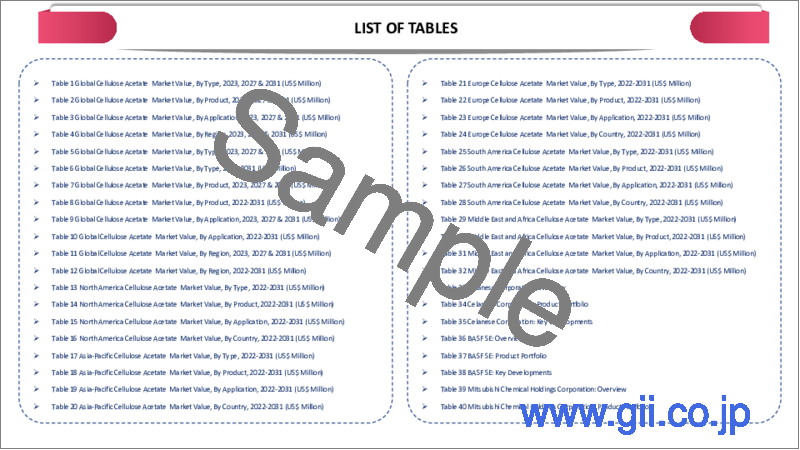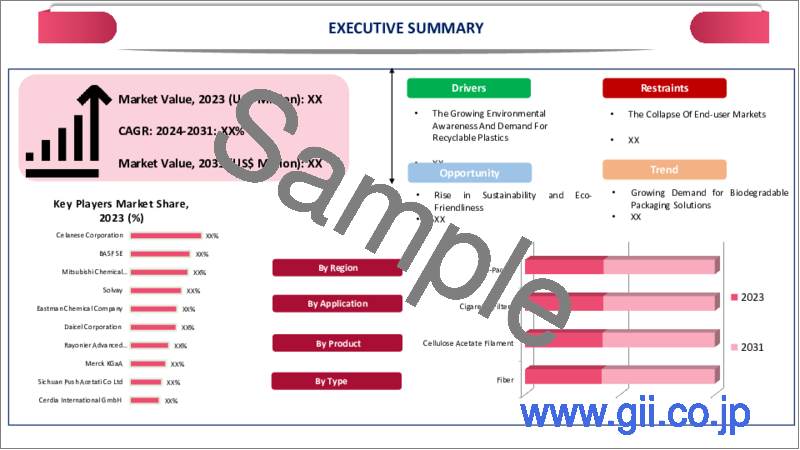|
|
市場調査レポート
商品コード
1336726
酢酸セルロースの世界市場-2023年~2030年Global Cellulose Acetate Market - 2023-2030 |
||||||
カスタマイズ可能
適宜更新あり
|
|||||||
| 酢酸セルロースの世界市場-2023年~2030年 |
|
出版日: 2023年08月22日
発行: DataM Intelligence
ページ情報: 英文 195 Pages
納期: 即日から翌営業日
|
- 全表示
- 概要
- 目次
市場概要
世界の酢酸セルロース市場は、2022年に47億8,000万米ドルに達し、2023-2030年の予測期間中にCAGR 5.2%で成長し、2030年には77億5,000万米ドルに達すると予測されています。
酢酸セルロース市場の主な成長は、眼鏡、繊維、タバコフィルターという様々な分野からの需要の増加によるものです。たばこフィルターは、セルロースから派生した合成材料である酢酸セルロースから生産されます。酢酸セルロースの合成の性質とその分解プロセスは、この素材による環境汚染の減少につながります。酢酸セルロースが主要な役割を果たしているクリーンな環境に対する意識は、これらの要因のために酢酸セルロース市場の成長があります。
アジア太平洋地域は酢酸セルロース市場で大きな成長を遂げました。さらに、中国、日本、インドなどの国々も、酢酸セルロースの生産と開発に同等の貢献をしています。例えば、2023年4月3日、GREEN SEA 瀬戸内ひろしま・プラットフォームの発展のために、株式会社近畿日本ツーリスト商事はプラスチック廃棄物削減のために介入し、木材から派生した酢酸セルロースで構成されたハンドルの歯ブラシの使用を開始しました。
市場力学
吸殻リサイクルが酢酸セルロース市場を牽引
タバコの吸殻は環境汚染の重大な原因であり、その分解によって吸殻に含まれる主要成分である酢酸セルロースが放出されます。しかし、吸殻から酢酸セルロースをリサイクルするには、有毒物質が存在するため、かなりの課題があります。それにもかかわらず、タバコの吸殻のリサイクル解決策を開発するための努力が続けられています。
この分野における模範的なプロジェクトが、2023年3月16日にオーストラリアの慈善団体によって開始されたCigCycleです。CigCycleの主な目的は、革新的な手段で吸殻問題に取り組むことです。このプロジェクトでは、吸殻に含まれる酢酸セルロースを栄養源として利用するため、菌類を採用しています。菌類は有毒成分を分解することで材料を効果的に分解し、最終的にクリーンな製品別を生産します。
このような革新的なリサイクル・アプローチを実施することで、酢酸セルロース市場は大きな利益を得ることができます。このような取り組みが普及し、環境への害を減らす効果が実証されれば、酢酸セルロースの需要を牽引し、より持続可能で環境に優しい未来に貢献することができます。
プラスチック汚染に対する持続可能な解決策としての酢酸セルロース
プラスチック汚染とその環境への影響に対する意識の高まりから、持続可能な代替品への需要が高まっています。再生可能な資源と生分解性から生まれた酢酸セルロースは、こうした懸念に対応し、プラスチック廃棄物を削減する実行可能な解決策を提供します。こうした要因が酢酸セルロース市場の成長を後押ししています。
2023年、フィルトローナはプラスチックフリーの革新的製品、ECOチューブ・トリプル・カーボン・フィルターを発売しました。ECOチューブ・トリプル・カーボン・フィルターは、EUの単一使用プラスチック指令に準拠し、生分解性を実現しています。社内研究によると、わずか90日以内に90%の生分解を達成します。
低い耐熱性と高い製造コスト
酢酸セルロースは耐熱性が低いため、高温や熱処理を伴う場面での使用が制限されます。酢酸セルロースは温度変化にさらされると軟化したり変形したりすることがあり、構造的完全性や性能に影響を及ぼします。そのため、熱にさらされることが重要な要素となる用途には適していません。
酢酸セルロースの生産には特定の資源と加工方法が必要であり、そのコストと市場での入手性に影響を与える可能性があります。従来のプラスチックに比べ、酢酸セルロースは生産コストが高い場合があり、特定の用途への普及が制限される可能性があります。
COVID-19影響分析
COVID期間中、消費者の主な関心は健康と衛生です。そのため、個人用保護具(PPE)の需要が高まっています。酢酸セルロースベースの素材、特に不織布の形態が使用されます。マスクや手袋の生産は、これらの素材の需要を増加させます。
このパンデミックは、消費者の行動や嗜好に変化をもたらします。例えば、喫煙を減らすタバコのフィルター需要が減少します。たばこ用フィルターはこの素材の重要な用途であるため、これは酢酸セルロース市場に直接影響を与えます。経済の不確実性、個人消費の減少、非必需品の制限により、パンデミックの間、多くの産業が需要の減少に直面しました。
ロシア・ウクライナ戦争の影響
ロシア・ウクライナ戦争により、木材パルプなどの原料供給が影響を受けた。また、酢酸セルロース製品の輸出入ビジネスにも影響を与え、酢酸セルロースの成長に影響を与えました。このような製品の不足は、価格の変動や遅れにつながります。これらの要因により、酢酸セルロース市場の成長には下降が見られます。
ロシア・ウクライナ戦争は多くの地域に影響を及ぼしています。この危機のため、投資家や企業はそのような地域への長期投資を行っていません。この地域で活動する企業は、顧客の需要を満たすために多くの困難に直面しています。戦争が原因で、市場は酢酸セルロース材料の成長と生産を減速させる地政学的問題に直面しています。
目次
第1章 調査手法と調査範囲
第2章 定義と概要
第3章 エグゼクティブサマリー
第4章 市場力学
- 影響要因
- 促進要因
- 吸殻からの酢酸セルロースのリサイクル
- プラスチック汚染に対する持続可能な解決策としての酢酸セルロース
- 抑制要因
- 耐熱性の低さと製造コストの高さ
- 機会
- 影響分析
- 促進要因
第5章 産業分析
- ポーターのファイブフォース分析
- サプライチェーン分析
- 価格分析
- 規制分析
第6章 COVID-19分析
第7章 タイプ別
- 繊維
- プラスチック
第8章 製品別
- 酢酸セルロースフィラメント
- セルロースエステルプラスチック
- 酢酸セルローストウ
- 酢酸セルロースフレーク
- その他
第9章 化学別
- 二酢酸セルロース
- 三酢酸セルロース
- 酪酸酢酸セルロース
- 酢酸プロピオン酸セルロース
第10章 用途別
- タバコフィルター
- 繊維・アパレル
- 写真フィルム
- テープ・ラベル
- その他
第11章 地域別
- 北米
- 米国
- カナダ
- メキシコ
- 欧州
- ドイツ
- 英国
- フランス
- イタリア
- ロシア
- その他欧州
- 南米
- ブラジル
- アルゼンチン
- その他南米
- アジア太平洋
- 中国
- インド
- 日本
- オーストラリア
- その他アジア太平洋地域
- 中東・アフリカ
第12章 競合情勢
- 競合シナリオ
- 市況/シェア分析
- M&A分析
第13章 企業プロファイル
- Eastman Chemical Company.
- 会社概要
- 製品ポートフォリオと説明
- 財務概要
- 主な発展
- Daicel Corporation
- Celanese Corporation
- Mitsubishi Chemical Holdings Corporation
- Sappi Ltd
- Rayonier Advanced Materials, Inc
- Nippon Shokubai Co. Ltd.
- China National Tobacco Corporation
- Sichuan Push Acetati Co Ltd
- Cerdia International GmbH
第14章 付録
Market Overview
The Global Cellulose Acetate Market reached US$ 4.78 billion in 2022 and is expected to reach US$ 7.75 billion by 2030 growing with a CAGR of 5.2% during the forecast period 2023-2030.
The major growth in the cellulose acetate market is due to increasing demand from various sectors named eyewear, textile, and cigarette filters. Cigarette filters are produced from cellulose acetate which is a synthetic material derived from cellulose. The synthetic nature of cellulose acetate and its degradation process leads to decreased environmental pollution caused by this material. Awareness towards the clean environment where cellulose acetate plays a major role due to these factors there is growth in the cellulose acetate market.
Asia Pacific experienced significant growth in the cellulose acetate market. Furthermore, countries such as China, Japan, and India also have equal contributions to the production and development, of cellulose acetate. For instance on, 3 April 2023, for the growth of the Green Sea Setouchi Hiroshima initiative, the trading company Kinki advnippon Tourist stepped in for reducing plastic waste and started using toothbrushes with handles made up of cellulose acetate which is derived from wood.
Market Dynamics
Driving the Cellulose Acetate Market through Cigarette Butt Recycling
Cigarette butts are a significant source of environmental pollution, and their decomposition releases cellulose acetate, a key component present in them. However, recycling cellulose acetate from these butts poses a considerable challenge due to the presence of toxic materials. Nonetheless, ongoing efforts are being made to develop recycling solutions for cigarette butts.
An exemplary project in this realm is CigCycle, initiated by an Australian charity on 16th March 2023. The primary objective of CigCycle is to address the cigarette butt issue through innovative means. This project employs fungi, utilizing the cellulose acetate present in the butts as a source of nutrition. The fungi effectively decompose the materials by breaking down toxic components, ultimately producing a clean by-product.
By implementing such innovative recycling approaches, the cellulose acetate market stands to benefit significantly. As these initiatives gain traction and demonstrate their efficacy in reducing environmental harm, they can drive the demand for cellulose acetate, contributing to a more sustainable and eco-friendly future.
Cellulose Acetate a Sustainable Solution to Plastic Pollution
Increasing awareness of plastic pollution and its impact on the environment has led to a growing demand for sustainable alternatives. Cellulose acetate derived from renewable sources and biodegradable addresses these concerns and provides a viable solution to reduce plastic waste. These factors boost the growth of the cellulose acetate market.
In 2023, Filtrona launched its plastic-free innovation, ECO Tube Triple Carbon Filter. The ECO Tube Triple Carbon Filter complies with the EU Single Use Plastics Directive and makes it biodegradable. Internal studies indicate that it achieves 90 percent biodegradation within just 90 days.
Lower Heat Resistance and High Production Cost
The limitation of lower heat resistance in cellulose acetate restricts its application in scenarios involving high temperatures or thermal processing. When subjected to changes in temperatures cellulose acetate may start to soften or deform which affects its structural integrity and performance. As a result, it is not suitable for applications where exposure to heat is a significant factor.
The production of cellulose acetate involves specific resources and processing methods that can impact its cost and availability in the market. Compared to conventional plastics, cellulose acetate may sometimes be more expensive to produce, which can limit its widespread adoption in certain applications.
COVID-19 Impact Analysis
During COVID consumers main focus is on health and hygiene. This increases the demand of personal protective equipment (PPE). Cellulose acetate-based materials, particularly in the form of non-woven fabrics are used. The production of masks and gloves increases the demand for these materials.
This pandemic causes shifts in consumer behavior and preferences. For example, there is a decrease in the demand for cigarette filters which reduces smoking. This directly impacts the cellulose acetate market as cigarette filters are a significant application of the material. Many industries faced a decline in demand during the pandemic due to economic uncertainties, reduced consumer spending, and restrictions on non-essential goods
Russia-Ukraine War Impact
Due to the Russia-Ukraine war, the supply of raw materials such as wood pulp got affected. It also impacted the export and import business of cellulose acetate products which affected the growth of cellulose acetate. Shortage of these products results in fluctuating prices and delays. Due to these factors, there is a downfall in the growth of the cellulose acetate market.
The Russia-Ukraine war affects many regions. Due to this crisis, investors and businesses don't commit to long-term investments in such regions. Companies working in this region face many difficulties to fulfill customer demand. Due to the war market phases geopolitical issues which slow downs the growth and production of the cellulose acetate materials.
Segment Analysis
The global cellulose acetate is segmented based on type, product, chemistry, application, and region.
Cellulose Acetate Filament a Sustainable Solution for 3D Printing Materials
Cellulose acetate filament is a type of filament used in 3D printing materials made up of cellulose acetate filament. This acetate is derived from wood pulp and cotton fibers. Cellulose acetate filament offers eco-friendly alternative solutions when compared to traditional petroleum-based plastics which are commonly used in 3D printing. Due to its extrusion and printing properties that allow a smooth 3D printing process.
In 2023, Cellulose acetate is being utilized as a sustainable and eco-friendly material in 3D printing, particularly in the production of furniture showcased at Salone del Mobile 2023 in Milano. ExtraBold Co., Ltd., a Japanese manufacturer of large format extrusion 3D printing systems collaborated with design lab honoka to create the tatami refab project. The process included mixing biodegradable resin specifically cellulose acetate with the raw material from discarded Tatami mats.
Geographical Penetration
Asia-Pacific Witnesses Significant Growth in Cellulose Acetate Market
Asia-Pacific is analyzed to witness fastest growth cellulose acetate market. Countries like China, Japan, and India has the highest production growth rate of cellulose acetate which is due to the increase in population, which further increases the plastic waste that made the consumption of more cellulose acetate in the region.
For instance, on 3 Feb 2020, Eastman launched the sustainable source Naia a new staple fiber that provides expansion in the fashion industry. This fiber is versatile in nature and it's an eco-friendly material. The raw material used in the production of Naia fiber comes from pine and eucalyptus forests and plantations. The company follows guidelines and standards for forestry supply chain management systems. For the creation of Naia, Eastman collaborates with many different companies globally.
Competitive Landscape
The major global players in the market include: Eastman Chemical Company, Daicel Corporation, Celanese Corporation, Mitsubishi Chemical Holdings Corporation, Sappi Ltd, Rayonier Advanced Materials, Inc, China National Tobacco Corporation, Sichuan Push Acetati Co Ltd, Cerdia International GmbH.
Why Purchase the Report?
- To visualize the global cellulose acetate market segmented based on type, product, chemistry, application and region, as well as understand key commercial assets and players.
- Identify commercial opportunities by analyzing trends and co-development.
- Excel data sheet with numerous data points of cellulose acetate market-level with all segments.
- PDF report consists of a comprehensive analysis after exhaustive qualitative interviews and an in-depth study.
- Product mapping available as excel consisting of key product of all the major players.
The global cellulose acetate market report would provide approximately 69 tables, 70 figures, and 195 Pages
Target Audience 2023
- Manufacturers/ Buyers
- Industry Investors/Investment Bankers
- Research Professionals
- Emerging Companies
Table of Contents
1. Methodology and Scope
- 1.1. Research Methodology
- 1.2. Research Objective and Scope of the Report
2. Definition and Overview
3. Executive Summary
- 3.1. Snippet By Type
- 3.2. Snippet By Product
- 3.3. Snippet By Chemistry
- 3.4. Snippet By Application
- 3.5. Snippet by Region
4. Dynamics
- 4.1. Impacting Factors
- 4.1.1. Drivers
- 4.1.1.1. Recycling Cellulose Acetate from Cigarette Butts
- 4.1.1.2. Cellulose Acetate a Sustainable Solution to Plastic Pollution
- 4.1.2. Restraints
- 4.1.2.1. Lower Heat Resistance and High Production Cost
- 4.1.3. Opportunity
- 4.1.4. Impact Analysis
- 4.1.1. Drivers
5. Industry Analysis
- 5.1. Porter's Five Force Analysis
- 5.2. Supply Chain Analysis
- 5.3. Pricing Analysis
- 5.4. Regulatory Analysis
6. COVID-19 Analysis
- 6.1. Analysis of COVID-19
- 6.1.1. Scenario Before COVID
- 6.1.2. Scenario During COVID
- 6.1.3. Scenario Post COVID
- 6.2. Pricing Dynamics Amid COVID-19
- 6.3. Demand-Supply Spectrum
- 6.4. Government Initiatives Related to the Market During Pandemic
- 6.5. Manufacturers Strategic Initiatives
- 6.6. Conclusion
7. By Type
- 7.1. Introduction
- 7.1.1. Market Size Analysis and Y-o-Y Growth Analysis (%), By Type
- 7.1.2. Market Attractiveness Index, By Type
- 7.2. Fiber *
- 7.2.1. Introduction
- 7.2.2. Market Size Analysis and Y-o-Y Growth Analysis (%)
- 7.3. Plastic
8. By Product
- 8.1. Introduction
- 8.1.1. Market Size Analysis and Y-o-Y Growth Analysis (%), By Product
- 8.1.2. Market Attractiveness Index, By Product
- 8.2. Cellulose Acetate Filament*
- 8.2.1. Introduction
- 8.2.2. Market Size Analysis and Y-o-Y Growth Analysis (%)
- 8.3. Cellulose Ester Plastics
- 8.4. Cellulose Acetate Tow
- 8.5. Cellulose Acetate Flakes
- 8.6. Others
9. By Chemistry
- 9.1. Introduction
- 9.1.1. Market Size Analysis and Y-o-Y Growth Analysis (%), By Chemistry
- 9.1.2. Market Attractiveness Index, By Chemistry
- 9.2. Cellulose Dicetate *
- 9.2.1. Introduction
- 9.2.2. Market Size Analysis and Y-o-Y Growth Analysis (%)
- 9.3. Cellulose Triacetate
- 9.4. Cellulose Acetate-Butyrate
- 9.5. Cellulose Acetate-Propionate
10. By Application
- 10.1. Introduction
- 10.1.1. Market Size Analysis and Y-o-Y Growth Analysis (%), By Application
- 10.1.2. Market Attractiveness Index, By Application
- 10.2. Cigarette Filters *
- 10.2.1. Introduction
- 10.2.2. Market Size Analysis and Y-o-Y Growth Analysis ()
- 10.3. Textile & Apparel
- 10.4. Photographic Films
- 10.5. Tape & Labels
- 10.6. Others
11. By Region
- 11.1. Introduction
- 11.1.1. Market Size Analysis and Y-o-Y Growth Analysis (%), By Region
- 11.1.2. Market Attractiveness Index, By Region
- 11.2. North America
- 11.2.1. Introduction
- 11.2.2. Key Region-Specific Dynamics
- 11.2.3. Market Size Analysis and Y-o-Y Growth Analysis (%), By Type
- 11.2.4. Market Size Analysis and Y-o-Y Growth Analysis (%), By Product
- 11.2.5. Market Size Analysis and Y-o-Y Growth Analysis (%), By Chemistry
- 11.2.6. Market Size Analysis and Y-o-Y Growth Analysis (%), By Application
- 11.2.7. Market Size Analysis and Y-o-Y Growth Analysis (%), By Country
- 11.2.7.1. U.S.
- 11.2.8. Canada
- 11.2.9. Mexico
- 11.3. Europe
- 11.3.1. Introduction
- 11.3.2. Key Region-Specific Dynamics
- 11.3.3. Market Size Analysis and Y-o-Y Growth Analysis (%), By Type
- 11.3.4. Market Size Analysis and Y-o-Y Growth Analysis (%), By Product
- 11.3.5. Market Size Analysis and Y-o-Y Growth Analysis (%), By Chemistry
- 11.3.6. Market Size Analysis and Y-o-Y Growth Analysis (%), By Application
- 11.3.7. Market Size Analysis and Y-o-Y Growth Analysis (%), By Country
- 11.3.7.1. Germany
- 11.3.7.2. UK
- 11.3.7.3. France
- 11.3.7.4. Italy
- 11.3.7.5. Russia
- 11.3.7.6. Rest of Europe
- 11.4. South America
- 11.4.1. Introduction
- 11.4.2. Key Region-Specific Dynamics
- 11.4.3. Market Size Analysis and Y-o-Y Growth Analysis (%), By Type
- 11.4.4. Market Size Analysis and Y-o-Y Growth Analysis (%), By Product
- 11.4.5. Market Size Analysis and Y-o-Y Growth Analysis (%), By Chemistry
- 11.4.6. Market Size Analysis and Y-o-Y Growth Analysis (%), By Application
- 11.4.7. Market Size Analysis and Y-o-Y Growth Analysis (%), By Country
- 11.4.8. Brazil
- 11.4.9. Argentina
- 11.4.10. Rest of South America
- 11.5. Asia-Pacific
- 11.5.1. Introduction
- 11.5.2. Key Region-Specific Dynamics
- 11.5.3. Market Size Analysis and Y-o-Y Growth Analysis (%), By Type
- 11.5.4. Market Size Analysis and Y-o-Y Growth Analysis (%), By Product
- 11.5.5. Market Size Analysis and Y-o-Y Growth Analysis (%), By Chemistry
- 11.5.6. Market Size Analysis and Y-o-Y Growth Analysis (%), By Application
- 11.5.7. Market Size Analysis and Y-o-Y Growth Analysis (%), By Country
- 11.5.7.1. China
- 11.5.7.2. India
- 11.5.7.3. Japan
- 11.5.7.4. Australia
- 11.5.7.5. Rest of Asia-Pacific
- 11.6. Middle East and Africa
- 11.6.1. Introduction
- 11.6.2. Key Region-Specific Dynamics
- 11.6.3. Market Size Analysis and Y-o-Y Growth Analysis (%), By Type
- 11.6.4. Market Size Analysis and Y-o-Y Growth Analysis (%), By Product
- 11.6.5. Market Size Analysis and Y-o-Y Growth Analysis (%), By Chemistry
- 11.6.6. Market Size Analysis and Y-o-Y Growth Analysis (%), By Application
12. Competitive Landscape
- 12.1. Competitive Scenario
- 12.2. Market Positioning/Share Analysis
- 12.3. Mergers and Acquisitions Analysis
13. Company Profiles
- 13.1. Eastman Chemical Company. *
- 13.1.1. Company Overview
- 13.1.2. Product Portfolio and Description
- 13.1.3. Financial Overview
- 13.1.4. Key Developments
- 13.2. Daicel Corporation
- 13.3. Celanese Corporation
- 13.4. Mitsubishi Chemical Holdings Corporation
- 13.5. Sappi Ltd
- 13.6. Rayonier Advanced Materials, Inc
- 13.7. Nippon Shokubai Co. Ltd.
- 13.8. China National Tobacco Corporation
- 13.9. Sichuan Push Acetati Co Ltd
- 13.10. Cerdia International GmbH
LIST NOT EXHAUSTIVE
14. Appendix
- 14.1. About Us and Services
- 14.2. Contact Us





